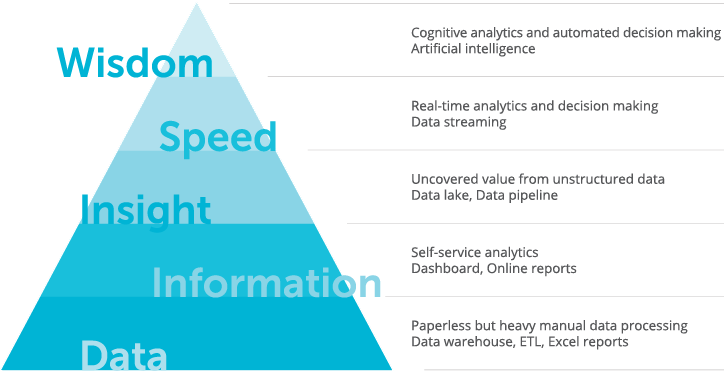A maturity model is considered a useful tool to assess the current effectiveness of any organization in a particular area. Big Data is no exception; there are multiple models from software vendors such as IBM, Hortonworks, and professional communities like TDWI. While they are mostly focused on capabilities and readiness from an executive sponsorship and organizational standpoint, it’s also helpful to assess the company’s unrealized potential from an uncovered Big Data value perspective.
Today, it’s difficult to find any organization that isn’t investing in storing, processing, and extracting value from their growing data. However, once companies have become capable of collecting and processing massive data, the question then becomes: “How can I get the maximum value out of it?” Every company is at a different point in its Big Data journey, so maximizing its business value means moving Big Data adoption to the next stage.
To illustrate possible stages, we will use an adaptation of the Data-Information-Knowledge-Wisdom pyramid, one of the fundamental and widely-recognized concepts regarding the data value chain. We use this model because it is easy to understand and its illustration speaks for itself.

This is a simplified example of an enterprise Big Data architecture at the “Wisdom” level. On top of this picture you may notice two groups of users in this AI-based solution – Augmented Intelligence and Intelligent Automation.
The main difference between them is that Augmented Intelligence scenarios help people make decisions through personal devices (mobile, smart watch, laptop, etc.) and Intelligent Automation (IA) does not require human interaction at all. In fact, the IA system talks to industry robots, cars, or legacy software applications by mimicking humans, and is also called Robotics Process Automation, or RPA.
It is worth mentioning that not all company departments can be at the same level of Big Data adoption maturity. In fact, it’s rather an exception across an industry. But what is most common among departments is that they can elevate their maturity level and get more value from data with machine learning in spite of a corporate function.
To learn more about how the Big Data Maturity Model and Machine Leaning can work for you, check out our latest whitepaper, “Machine Learning: Making Big Data Work for the Enterprise”.

